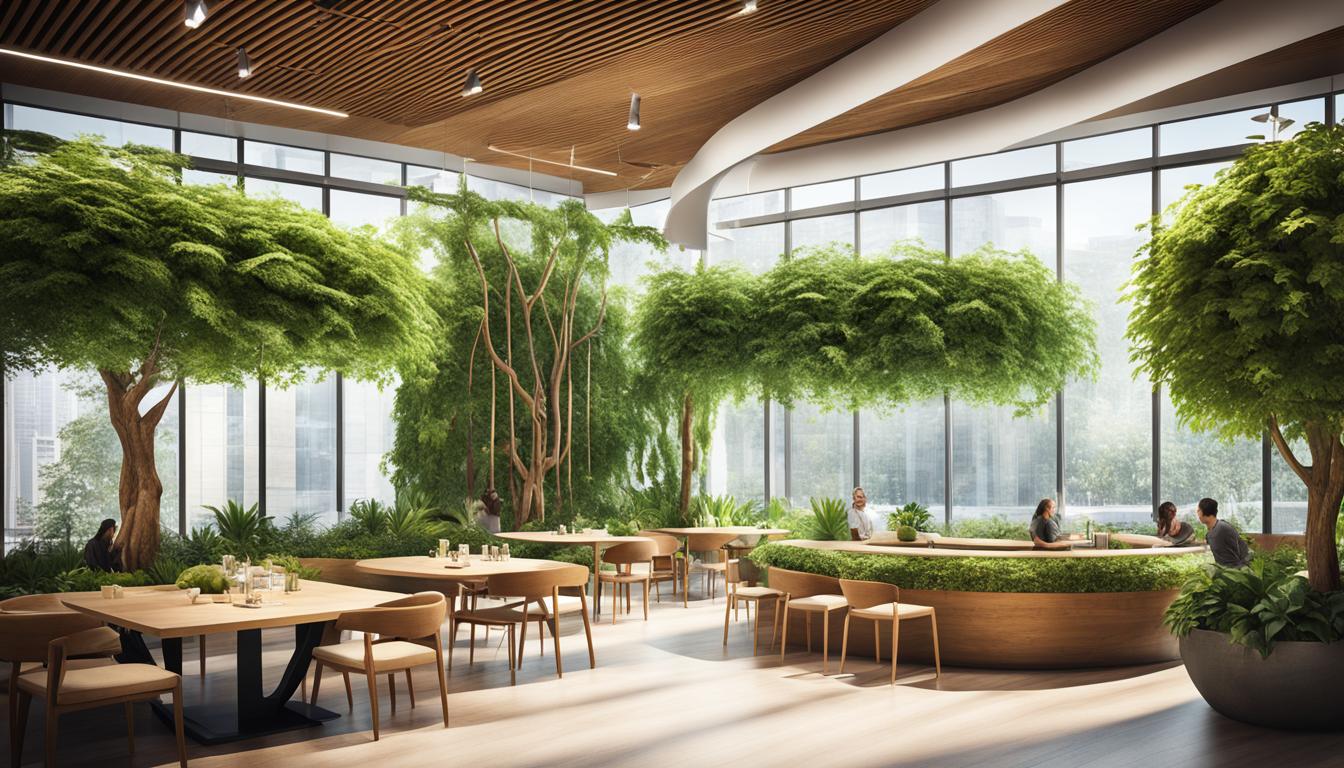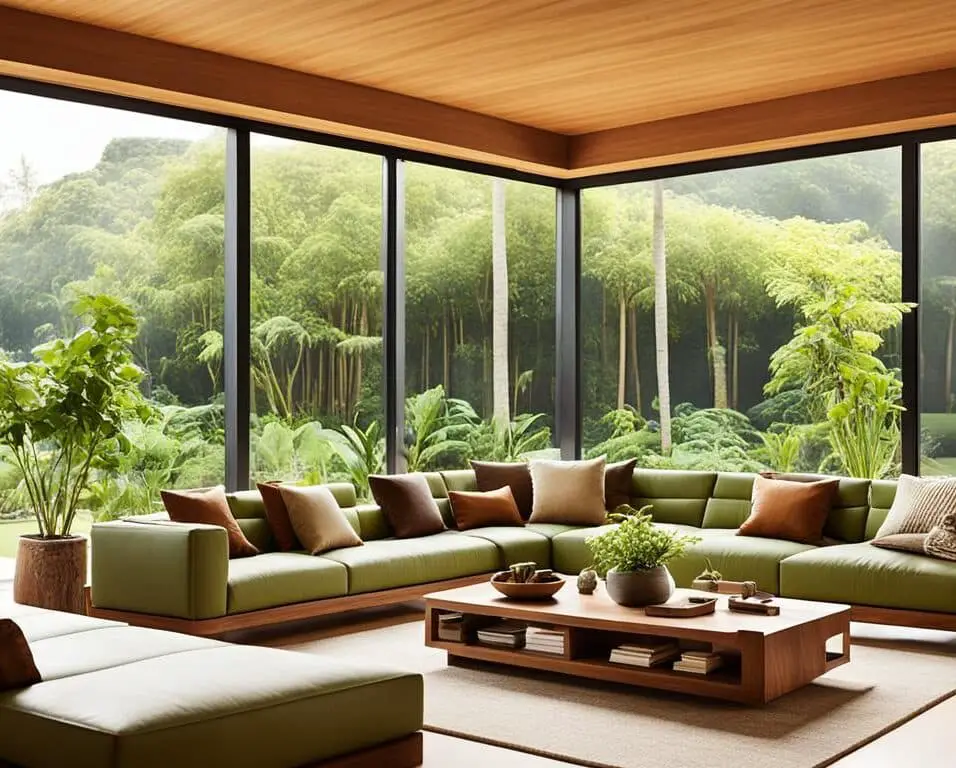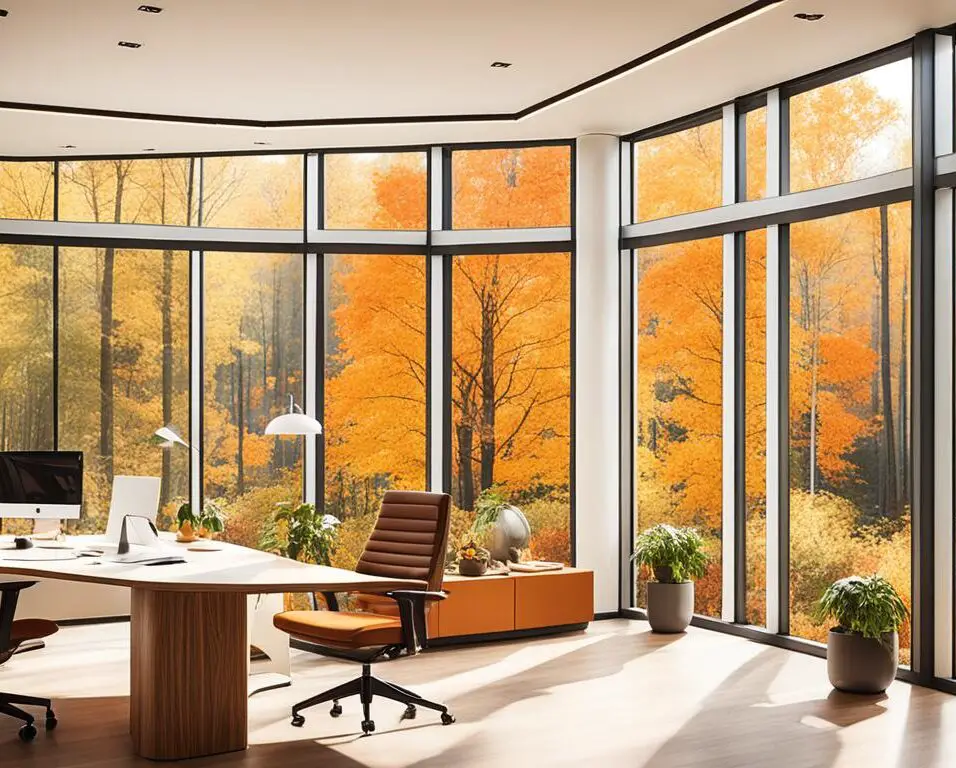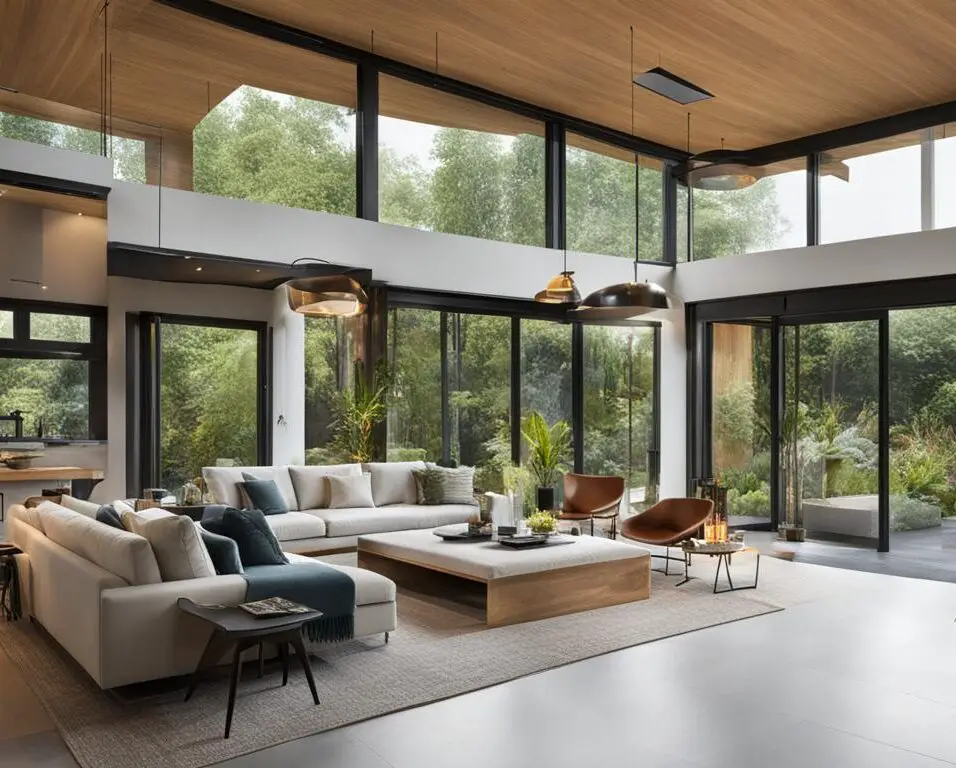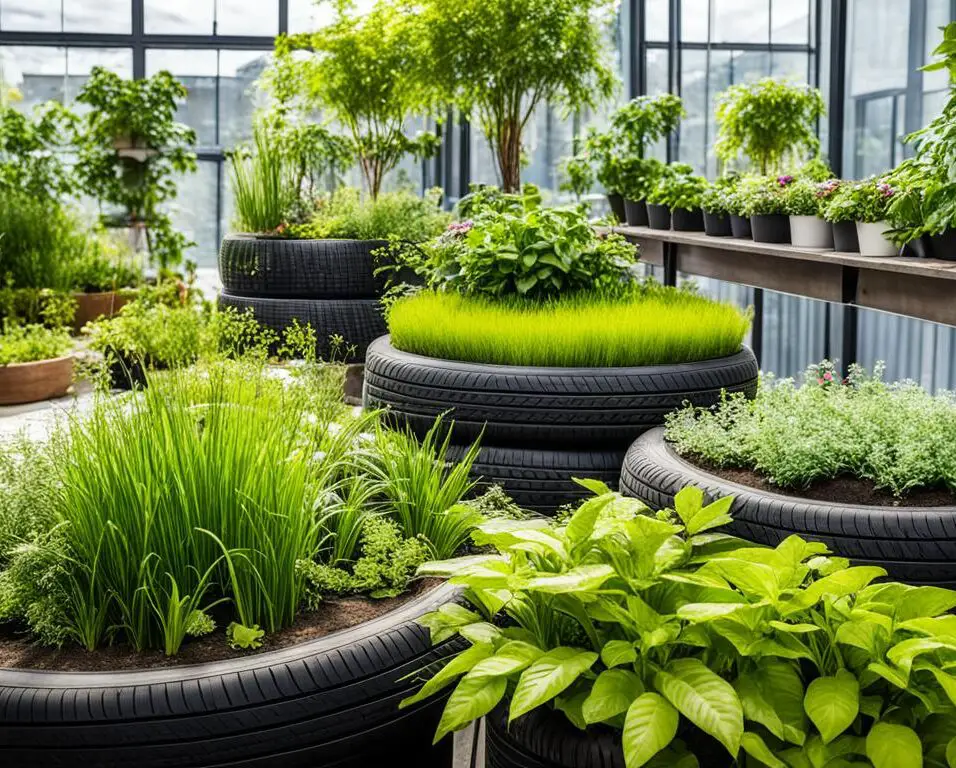The History and Evolution of Biophilic Design
Biophilic design, with its emphasis on connectivity to nature and its positive impact on our well-being, has a rich history and has evolved significantly over time. This approach to architecture and interior design recognizes the innate human desire to be in natural environments and seeks to incorporate natural elements into our built spaces.
The history of biophilic design can be traced back to the early 20th century, where innovative concepts and designs began to shape the way we interact with our living spaces. From the emergence of prefabricated houses to futuristic designs that prioritized natural light and greenery, the foundations of biophilic design were laid.
Over the years, the concept of biophilic design has expanded to encompass a wide range of elements. It now incorporates the use of natural materials, such as wood and stone, the integration of plants, and the maximization of natural light. Studies have shown that these principles have a positive impact on our mental health, productivity, and creativity.
As our understanding of the benefits of biophilic design grows, it has found its way into various fields. It has influenced architecture, shaping the way buildings are designed and constructed, with an emphasis on sustainability and green building practices. It has also transformed interior design, with a focus on nature-inspired materials, indoor plants, and natural patterns and textures.
Biophilic design has proven to be particularly effective in workspaces, enhancing productivity, and employee well-being. Its application in healthcare settings has also led to improved patient outcomes and reduced stress levels. Educational spaces, such as schools and universities, have embraced biophilic design to create optimal learning environments that enhance cognitive function and student well-being.
Overall, the history and evolution of biophilic design highlight its profound impact on our well-being and our connection to nature. By prioritizing biophilic design principles, we can create spaces that not only enhance our physical and mental health but also contribute to a more sustainable and harmonious relationship with the natural world.
Key Takeaways:
- The history of biophilic design dates back to the early 20th century, with innovative concepts and designs shaping the way we interact with our living spaces.
- Biophilic design incorporates natural elements, such as natural materials, plants, and natural light, to improve mental health, productivity, and creativity.
- It has influenced architecture, interior design, workspaces, healthcare settings, and educational spaces, emphasizing the positive impact of nature on our well-being and connectivity to the environment.
- Biophilic design principles can enhance employee well-being, patient outcomes, student engagement, and overall quality of life.
- By prioritizing biophilic design, we can create spaces that promote well-being, sustainability, and a harmonious relationship with the natural world.
The Origins of Biophilic Design
The origins of biophilic design can be traced back to the groundbreaking work of biologist Edward O. Wilson and his concept of biophilia hypothesis. According to Wilson, humans have an innate connection to nature and a deep-seated desire to be in natural environments. This hypothesis has had a transformative impact on the world of design, leading to the integration of natural elements into architectural and interior spaces.
Wilson’s biophilia hypothesis laid the foundation for biophilic design, which seeks to create built environments that mimic nature and foster a sense of well-being and connection. This approach involves the use of natural materials such as wood and stone, the incorporation of natural light, and the inclusion of indoor green spaces. By bringing elements of nature into our surroundings, biophilic design aims to promote relaxation, reduce stress, and enhance our overall quality of life.
“The implementation of biophilic design principles in our built environments can have profound positive effects on our well-being and mental health.” – Edward O. Wilson
The integration of natural elements in design goes beyond aesthetics. Research has shown that exposure to nature has a calming effect on our minds and bodies, improving our cognitive function, productivity, and creativity. Biophilic design not only enhances our connection to nature but also promotes sustainable practices by encouraging the use of renewable resources and reducing energy consumption.
To illustrate the principles of biophilic design, let’s explore some examples:
Examples of Biophilic Design:
1. Incorporating natural light: Designing spaces with ample windows and skylights to maximize the use of natural sunlight, reducing the reliance on artificial lighting and creating a brighter, more inviting environment.
2. Using natural materials: Introducing elements such as wood, stone, and natural fibers into the design to create a sense of warmth, texture, and authenticity.
3. Creating indoor green spaces: Incorporating live plants, vertical gardens, and living walls to bring the beauty and benefits of nature indoors, improving air quality and providing a sense of tranquility.
4. Embracing natural patterns and textures: Using patterns inspired by nature, such as leaf motifs or organic shapes, and incorporating natural textures like stone finishes or woven fabrics to add depth and visual interest to the space.
By incorporating these biophilic design principles into our surroundings, we can create spaces that nurture our well-being, inspire creativity, and reconnect us with the natural world.
Biophilic Design in Architecture
Biophilic design principles have revolutionized the field of architecture, bringing a renewed focus on creating sustainable and nature-inspired buildings. Architects are now integrating biophilic elements into their designs to enhance the well-being of occupants and minimize the environmental impact of construction.
One of the key principles of biophilic architecture is maximizing natural light. By incorporating large windows, skylights, and lightwells, architects can flood interior spaces with sunlight, reducing the need for artificial lighting and creating a connection to the outside world. Natural light not only improves the visual appeal of a building but also has numerous health benefits, including increased productivity and reduced eyestrain.
Another aspect of biophilic design in architecture is the integration of natural ventilation systems that mimic the airflow patterns found in nature. By designing buildings that allow for cross ventilation and incorporating operable windows, architects can create spaces that have a constant flow of fresh air, improving indoor air quality and reducing the reliance on mechanical ventilation systems.
Energy-efficient materials are also a hallmark of biophilic architecture. By utilizing sustainable building materials like bamboo, reclaimed wood, and recycled materials, architects can reduce the carbon footprint of a building and promote a more circular economy. Additionally, the use of energy-efficient insulation and reflective roofing materials helps minimize energy consumption and maintain comfortable indoor temperatures.
But biophilic design goes beyond just incorporating natural elements; it also encourages the creation of green spaces within the built environment. Architects are now incorporating living walls, rooftop gardens, and indoor green spaces to provide occupants with opportunities to connect with nature, even in urban settings. These green spaces not only enhance the aesthetic appeal of a building but also provide numerous health benefits, including stress reduction and improved air quality.
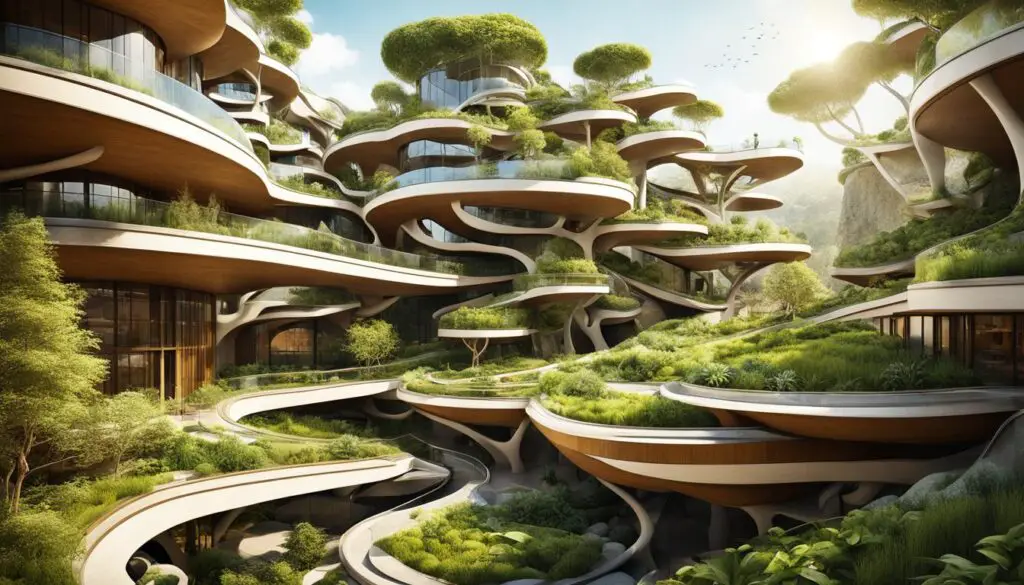
Biophilic design in architecture has spurred the development of innovative building materials that mimic natural elements. For example, biodegradable insulation made from natural fibers offers an environmentally friendly alternative to traditional insulation materials. Green roofs, which are covered in vegetation, help reduce urban heat island effect and provide a habitat for birds and insects.
By embracing biophilic design principles, architects are transforming the way buildings are designed and constructed, placing a greater emphasis on sustainability and the well-being of building occupants. Biophilic architecture creates spaces that are not only visually stunning but also promote a connection to nature, positively impacting our physical and mental health.
Biophilic Design in Interior Design
Biophilic design has had a profound influence on the field of interior design, revolutionizing the way we conceive and decorate indoor spaces. As a designer, I prioritize the use of nature-inspired materials, including robust reclaimed wood, exquisite stone, and luxurious natural fibers, to infuse the space with an authentic sense of natural beauty. These materials not only bring a touch of sophistication to the interiors but also establish a harmonious connection between the built environment and the natural world.
Indoor plants play a vital role in biophilic interior design, creating a refreshing ambiance and invigorating the atmosphere. By incorporating a variety of lush greenery, we not only enhance the air quality but also cultivate a connection to nature, evoking a sense of calm and tranquility within the space. The presence of living plants creates a living and dynamic environment, promoting a sense of well-being and improving the overall quality of the interior.
Furthermore, the integration of natural patterns and textures adds depth and visual interest to the design. From delicate leaf motifs that capture the essence of organic beauty to the timeless elegance of natural stone finishes, every element in the space contributes to a seamless blend of natural and man-made elements. These patterns and textures create a visual tapestry that appeals to our innate connection to nature, invoking a sense of relaxation and harmony.
By employing biophilic design principles in interior spaces, we can create environments that not only inspire and rejuvenate but also foster a deeper appreciation for the natural world. Through the efficient use of nature-inspired materials, the incorporation of indoor plants, and the presence of natural patterns and textures, biophilic interior design introduces the tranquility and beauty of nature into our everyday lives.
Below is a table summarizing the key elements of biophilic design in interior design:
| Key Elements of Biophilic Design in Interior Design |
|---|
| Nature-inspired materials (reclaimed wood, stone, natural fibers) |
| Indoor plants for improved air quality and connection to nature |
| Natural patterns and textures (leaf motifs, natural stone finishes) |
Remember, incorporating biophilic design principles into interior spaces not only enhances their aesthetic appeal but also contributes to our well-being by fostering a deeper connection with nature.
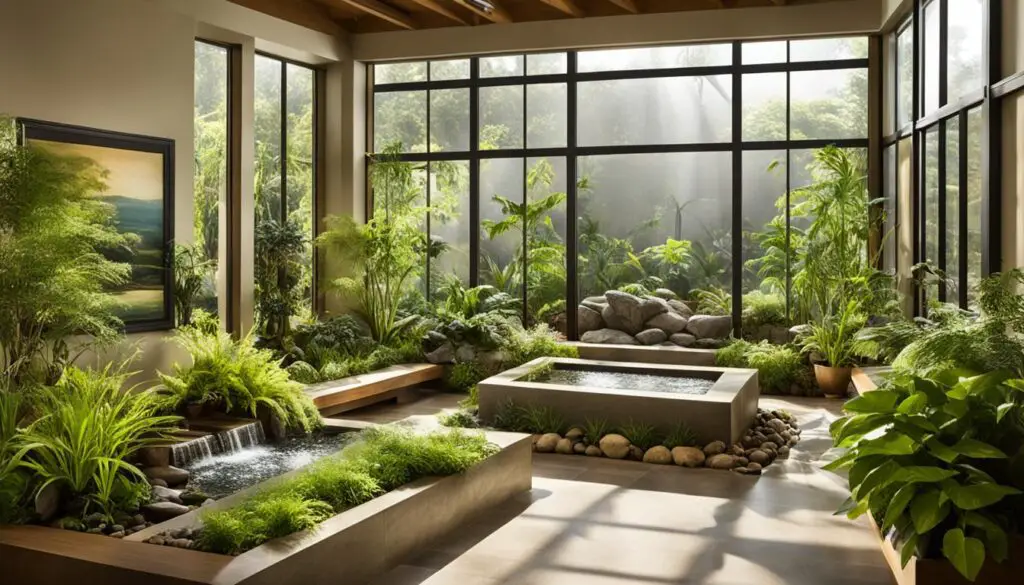
Biophilic Design in Workspaces
Biophilic design has proven to be a game-changer in workspaces, providing numerous benefits that contribute to enhanced productivity, improved employee well-being, and reduced stress levels. By incorporating elements inspired by nature, such as natural light, indoor plants, and views of the natural environment, offices and workplaces create an environment that fosters creativity, attention, and focus.
One of the key advantages of biophilic design in workspaces is its positive impact on employee satisfaction and morale. When employees are surrounded by nature-inspired elements, they feel more connected to the space and experience a greater sense of well-being. This, in turn, leads to higher levels of engagement and productivity, as employees are motivated and inspired to perform at their best.
Moreover, biophilic design elements can help reduce stress and improve overall mental health in the workplace. Natural light has been shown to regulate circadian rhythms and boost mood, while indoor plants purify the air and provide a calming effect. A study conducted by the University of Exeter found that employees working in offices with natural elements reported a 15% increase in well-being and productivity.
Furthermore, biophilic design creates a more positive and supportive work environment. By incorporating elements that mimic nature, such as organic shapes and patterns, textures, and colors found in the natural world, workspaces can evoke a sense of tranquility and relaxation. This creates a sanctuary-like atmosphere where employees feel more comfortable, fostering effective communication, collaboration, and teamwork.
Benefits of Biophilic Design in Workspaces
- Increased productivity: Studies have shown that workspaces designed with biophilic elements enhance focus, attention, and creativity, resulting in higher productivity levels.
- Improved employee well-being: By incorporating natural elements, biophilic design promotes a sense of calmness and positivity, contributing to improved mental and physical well-being for employees.
- Reduced stress levels: Elements such as natural light and indoor plants have been proven to reduce stress and promote relaxation, creating a harmonious work environment.
Biophilic design in workspaces has become more than just a trend; it is a philosophy that recognizes the importance of our innate connection with nature and leverages it to create productive, supportive, and inspiring workplaces.
| Benefits | Description |
|---|---|
| Increased productivity | Enhanced focus, attention, and creativity lead to higher productivity levels. |
| Improved employee well-being | Promotes mental and physical well-being, creating a positive work environment. |
| Reduced stress levels | Natural elements help reduce stress and foster relaxation. |
Biophilic Design in Healthcare Settings
Biophilic design has revolutionized the way hospitals and medical facilities are designed, creating healing environments that prioritize the well-being of patients. Extensive research has demonstrated the positive impact of biophilic design elements in healthcare settings, leading to faster recovery times and reduced stress levels for both patients and healthcare providers.
Natural light, views of nature, and nature-inspired artwork play a crucial role in creating a calming and healing environment for patients. Rather than sterile and impersonal spaces, hospitals that integrate biophilic design principles offer a sense of tranquility and connection to the natural world, promoting overall wellness during the healing process.
“The integration of biophilic design elements in healthcare settings has shown remarkable benefits for patient outcomes. By incorporating natural elements, we create a harmonious and soothing environment that supports the healing process.”
Access to outdoor spaces and green areas within healthcare facilities also lends itself to promoting physical activity and enhancing well-being. Patients can find solace in spending time outdoors, surrounded by the beauty and serenity of nature, which contributes to their overall recovery.
Benefits of Biophilic Design in Healthcare
- Promotes faster recovery times for patients
- Reduces stress levels and anxiety
- Improves overall well-being and patient satisfaction
- Enhances the healing process through a connection to nature
- Creates a calming and soothing environment for patients
Furthermore, the implementation of biophilic design in healthcare settings extends beyond patient benefits. Healthcare providers and staff also experience the positive effects of these environments, leading to improved job satisfaction, reduced stress levels, and ultimately, enhanced patient care.
The Future of Biophilic Design in Healthcare
The recognition of the vast benefits of biophilic design in healthcare settings has set the stage for further advancements in this field. As hospitals and medical facilities continue to prioritize patient well-being, the integration of biophilic design principles will become even more prevalent.
The future of biophilic design in healthcare lies in the exploration of innovative ways to incorporate natural elements into the built environment. This includes the use of cutting-edge technology to simulate natural lighting and the integration of green spaces and living walls within healthcare facilities. The goal is to create environments that nurture physical, emotional, and mental well-being, ensuring optimal conditions for healing and recovery.
Biophilic Design in Educational Spaces
Biophilic design principles have been widely embraced in educational spaces, such as schools and universities, as they strive to create optimal learning environments. Extensive studies have demonstrated the positive impact of incorporating natural elements in classrooms, including natural light, greenery, and views of nature, on cognitive function and student well-being.
Research has shown that students in biophilic learning spaces exhibit higher levels of engagement, concentration, and creativity. By connecting students to nature within the school environment, biophilic design fosters a sense of calmness and inspiration, allowing for enhanced learning experiences.
The use of natural light, for example, not only reduces eyestrain but also promotes a healthy sleep-wake cycle, leading to improved alertness and academic performance. Introducing greenery into classrooms has been found to have a positive effect on attention span, memory retention, and overall emotional well-being.
“Biophilic design in schools enhances cognitive function and student well-being, creating a positive and nurturing environment for learning.”
Studies have shown that exposure to nature and natural elements can significantly reduce stress levels among students. By providing spaces that visually and physically connect students to nature, schools can help alleviate the pressures and anxieties often associated with academic environments.
Additionally, biophilic design in educational spaces can have a profound impact on overall mental health. Providing access to natural views and incorporating biophilic elements into the design has been linked to reduced symptoms of anxiety and depression, promoting a positive and supportive atmosphere for learning.
Examples of Biophilic Design in Schools
To successfully implement biophilic design in schools, several strategies can be employed. These include:
- Maximizing natural light by incorporating large windows and skylights
- Integrating indoor plants and living walls for a dose of nature indoors
- Creating outdoor learning spaces that blend seamlessly with the surrounding environment
- Using natural materials and textures in furniture and finishes
By employing these strategies, schools can create educational environments that prioritize the well-being and cognitive development of their students, ultimately enhancing the overall learning experience.
| Benefits of Biophilic Design in Schools | Examples |
|---|---|
| Enhanced cognitive function | Improved memory retention |
| Higher levels of student engagement | Increased creativity |
| Reduced stress and anxiety | Improved emotional well-being |
Conclusion
Biophilic design has revolutionized the way we approach architecture and interior design, recognizing the crucial role of nature in our built environments. Through the history and evolution of biophilic design, we have witnessed its profound impact on our well-being, connection to nature, and overall quality of life.
Looking ahead, the future of biophilic design lies in the continued integration of sustainable practices and technologies into our buildings and spaces. By prioritizing biophilic design principles, we can create environments that not only enhance our physical and mental health but also contribute to a more sustainable and harmonious relationship with the natural world.
With biophilic design, the benefits are tangible. We experience improved air quality, reduced stress levels, increased productivity, and enhanced overall well-being. As a society, we are recognizing the importance of incorporating nature into our everyday spaces and the positive impacts it can have on our lives.
In an era where sustainability is paramount, biophilic design offers a pathway to creating spaces that are not only aesthetically pleasing but also environmentally conscious. By embracing biophilic design, we can foster a deeper connection with nature and build a more sustainable future for generations to come.
FAQ
What is biophilic design?
Biophilic design is an approach to architecture and interior design that aims to connect people with nature, improving their well-being and overall quality of life.
What is the history of biophilic design?
The history of biophilic design can be traced back to the early 20th century, where innovations such as prefabricated houses and futuristic designs began to shape the way we interact with our living spaces.
What are the origins of biophilic design?
The origins of biophilic design can be attributed to the biophilia hypothesis proposed by biologist Edward O. Wilson, which states that humans have an innate connection to nature.
How has biophilic design influenced architecture?
Biophilic design principles are now commonly integrated into sustainable and green buildings, with a focus on maximizing natural light, incorporating ventilation systems that mimic natural airflow, and utilizing energy-efficient materials.
How has biophilic design influenced interior design?
Interior designers now prioritize the use of nature-inspired materials, such as reclaimed wood, stone, and natural fibers, to bring a sense of natural beauty and authenticity into the space.
What are the benefits of biophilic design in workspaces?
Offices and workplaces that incorporate biophilic design elements have been found to enhance creativity, attention, and focus, as well as reduce stress and improve overall mental health.
How has biophilic design impacted healthcare settings?
Incorporating biophilic design elements in healthcare settings has been shown to have positive effects on patient outcomes, including faster recovery times and reduced stress levels.
How does biophilic design enhance educational spaces?
Studies have shown that incorporating natural elements in classrooms can enhance cognitive function, improve student well-being, and promote engagement, concentration, and creativity.
What is the future of biophilic design?
The future of biophilic design lies in further integrating sustainable practices and technologies into our buildings and spaces, contributing to a more sustainable and harmonious relationship with the natural world.



